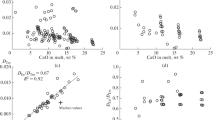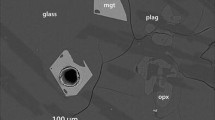Abstract
The effect of melt composition on the partitioning of trace elements between anorthite and silicate melts has been studied experimentally in five compositions in the system CaO–Al2O3–SiO2 (CAS) at ~ 1400 °C and four compositions in the system CaO–MgO–Al2O3–SiO2 (CMAS) at 1332 °C. Melt composition has a significant impact on the substitution of trace elements into anorthite, particularly if the trace-element substitution is aliovalent and requires a charge balance for substitution. Melt composition strongly influences the partitioning of the trivalent rare earth element (REE) cations into the large-cation site (M) of anorthite. Due to charge balance requirements, the activity of alumina in the melt is the most important compositional variable for the REE partitioning in anorthite. Scandium, another trivalent cation, is much more compatible than is predicted for trivalent cations partitioning on the M-site. Therefore, scandium is likely partitioning onto the tetrahedral site in place of aluminium, which requires no charge balance and therefore is not affected strongly by melt composition. Similarly, the partitioning of the small divalent cations (Be and Mg) show a stronger relationship with changing melt composition than the large divalent cations (Ca, Sr, and Ba) and therefore are likely to partition on the tetrahedral site (T) of plagioclase rather than the large-cation site (M). Detailed thermodynamic modelling of the effects of melt composition is required for an adequate parameterization of trace-element mineral/melt partition coefficients, in addition to models of the effects of mineral composition.

[modified from Levin et al. (1964)]












Similar content being viewed by others
References
Aigner-Torres M, Blundy J, Ulmer P, Pettke T (2007) Laser ablation ICPMS study of trace element partitioning between plagioclase and basaltic melts: an experimental approach. Contrib Mineral Petrol 153:647–667. https://doi.org/10.1007/s00410-006-0168-2
Bédard JH (2006) Trace element partitioning in plagioclase feldspar. Geochimica et Cosmochimica Acta 70:3717–3742. https://doi.org/10.1016/j.gca.2006.05.003
Berman RG (1983) A thermodynamic model for multicomponent melts, with application to the system CaO–MgO–Al2O3–SiO2. University of British Columbia
Berman RG, Brown TH (1984) A thermodynamic model for multicomponent melts, with application to the system CaO–Al2O3–SiO2. Geochimica et Cosmochimica Acta 48:661–678. https://doi.org/10.1016/0016-7037(84)90094-2
Bindeman IN, Davis AM (2000) Trace element partitioning between plagioclase and melt: investigation of dopant influence on partition behavior. Geochimica et Cosmochimica Acta 64:2863–2878
Bindeman I, Davis AM, Drake MJ (1998) Ion microprobe study of plagioclase-basalt partition experiments at natural concentration levels of trace elements. Geochimica et Cosmochimica Acta 62:1175–1193. https://doi.org/10.1016/S0016-7037(98)00047-7
Blundy JD, Wood B (1994) Prediction of crystal-melt partition coefficients from elastic moduli. Nature 372:452–454
Boyd FR, England JL (1960) Apparatus for phase-equilibrium measurements at pressures up to 50 kilobars and temperatures up to 1750 °C. J Geophys Res 65:741–748. https://doi.org/10.1029/JZ065i002p00741
Brice JC (1975) Some thermodynamic aspects of the growth of strained crystals. J Cryst Growth 28:249–253. https://doi.org/10.1016/0022-0248(75)90241-9
Burnham AD, Berry AJ (2014) The effect of oxygen fugacity, melt composition, temperature and pressure on the oxidation state of cerium in silicate melts. Chem Geol 366:52–60. https://doi.org/10.1016/j.chemgeo.2013.12.015
Burnham AD, Berry AJ, Halse HR, Schofield PF, Cibin G, Mosselmans JFW (2015) The oxidation state of europium in silicate melts as a function of oxygen fugacity, composition temperature. Chem Geol 411:248–259. https://doi.org/10.1016/j.chemgeo.2015.07.002
Dohmen R, Blundy J (2014) A predictive thermodynamic model for element partitioning between plagioclase and melt as a function of pressure, temperature and composition. Am J Sci 314:1319–1372. https://doi.org/10.2475/09.2014.04
Drake MJ, Weill DF (1975) Partition of Sr, Ba, Ca, Y, Eu2+, Eu3+, and other REE between plagioclase feldspar and magmatic liquid: an experimental study. Geochimica et Cosmochimica Acta 39:689–712. https://doi.org/10.1016/0016-7037(75)90011-3
Duffy JA (1993) A review of optical basicity and its applications to oxidic systems. Geochimica et Cosmochimica Acta 57:3961–3970. https://doi.org/10.1016/0016-7037(93)90346-X
Evans TM, O’Neill C, Tuff HS J (2008) The influence of melt composition on the partitioning of REEs, Y, Sc, Zr and Al between forsterite and melt in the system CMAS. Geochimica et Cosmochimica Acta 72:5708–5721. https://doi.org/10.1016/j.gca.2008.09.017
Ito J (1976) High temperature solvent growth of anorthite on the join CaAl2Si2O8–SiO2. Contrib Mineral Petrol 59:187–194. https://doi.org/10.1007/BF00371307
Jackson SE (ed) (2008) Calibration strategies for elemental analysis by LA–ICP–MS vol 40. Laser ablation–ICP–MS in the earth sciences: current practices and outstanding issues. Mineralogical Association of Canada, Vancouver. https://doi.org/10.2113/gsecongeo.104.4.601
Jochum KP et al (2011) Determination of reference values for NIST SRM 610–617 glasses following ISO guidelines. Geostand Geoanal Res 35:397–429. https://doi.org/10.1111/j.1751-908X.2011.00120.x
Levin EM, Robbins CR, McMurdie HF (1964) Phase diagrams for ceramists. The American Ceramic Society: Columbus
Libourel G, Boivin P, Biggar GM (1989) The univariant curve liquid = forsterite + anorthite + diopside in the system CMAS at 1 bar: solid solutions and melt structure. Contrib Mineral Petrol 102:406–421. https://doi.org/10.1007/bf00371084
Longhi J, Hays JF (1979) Phase equilibria and solid solution along the join CaAl2Si2O8–SiO2. Am J Sci 279:876–890. https://doi.org/10.2475/ajs.279.7.876
Longhi J, Walker D, Hays JF (1976) Fe and Mg in plagioclase. In: New York PP, Inc (ed) 7th lunar science conference, Houston, Texas pp 1281–1300
Megaw HD, Kempster CJE, Radoslovich EW (1962) The structure of anorthite, CaAl2Si2O8. II. Description discussion. Acta Crystallogr 15:1017–1035. https://doi.org/10.1107/S0365110X62002637
Miller SA, Asimow PD, Burnett DS (2006) Determination of melt influence on divalent element partitioning between anorthite and CMAS melts. Geochimica et Cosmochimica Acta 70:4258–4274. https://doi.org/10.1016/j.gca.2006.06.1547
Murakami H, Kimata M, Shimoda S (1992) Solubility of CaMgSi3O8 and []Si4O8 endmembers in anorthite. J Mineral Petrol Econ Geol 87:491–509. https://doi.org/10.2465/ganko.87.491
O’Neill HSC (2016) The smoothness and shapes of chondrite-normalized rare earth element patterns in basalts. J Petrol 57:1463–1508. https://doi.org/10.1093/petrology/egw047
O’Neill HSC, Eggins SM (2002) The effect of melt composition on trace element partitioning: an experimental investigation of the activity coefficients of FeO, NiO, CoO, MoO2 and MoO3 in silicate melts. Chem Geol 186:151–181. https://doi.org/10.1016/S0009-2541(01)00414-4
Onuma N, Higuchi H, Wakita H, Nagasawa H (1968) Trace element partition between two pyroxenes and the host lava. Earth Planet Sci Lett 5:47–51. https://doi.org/10.1016/S0012-821X(68)80010-X
Paton C, Hellstrom J, Paul B, Woodhead J, Hergt J (2011) Iolite: freeware for the visualisation and processing of mass spectrometric data. J Anal At Spectrom 26:2508–2518. https://doi.org/10.1039/C1JA10172B
Peters MT, Shaffer EE, Burnett DS, Kim SS (1995) Magnesium and titanium partitioning between anorthite and type B CAI liquid: dependence on oxygen fugacity and liquid composition. Geochimica et Cosmochimica Acta 59:2785–2796. https://doi.org/10.1016/0016-7037(95)00173-W
Shannon RD (1976) Revised effective ionic radii and systematic studies of interatomic distances in halides and chalcogenides. Acta Crystallogr 32:751–767 https://doi.org/10.1107/S0567739476001551
Sun C, Graff M, Liang Y (2017) Trace element partitioning between plagioclase and silicate melt: the importance of temperature and plagioclase composition, with implications for terrestrial and lunar magmatism. Geochimica et Cosmochimica Acta 206:273–295. https://doi.org/10.1016/j.gca.2017.03.003
Takahashi E, Irvine TN (1981) Stoichiometric control of crystal/liquid single-component partition coefficients. Geochimica et Cosmochimica Acta 45:1181–1185. https://doi.org/10.1016/0016-7037(81)90141-1
Tsuchiyama A, Takahashi E (1983) Melting kinetics of a plagioclase feldspar. Contrib Mineral Petrol 84:345–354. https://doi.org/10.1007/BF01160286
Ware NG (1981) Computer programs and calibration with the PIBS technique for quantitative electron probe analysis using a lithium-drifted silicon detector. Comput Geosci 7:167–184. https://doi.org/10.1016/0098-3004(81)90028-5
Williamson BJ, Herrington RJ, Morris A (2016) Porphyry copper enrichment linked to excess aluminium in plagioclase. Nat Geosci 9:237–241. https://doi.org/10.1038/ngeo2651
Wood BJ, Blundy JD (2014) 3.11—Trace element partitioning: the influences of ionic radius, cation charge, pressure, and temperature. In: Holland HD, Turekian KK (eds) Treatise on geochemistry (Second edition). Elsevier, Oxford, pp 421–448. https://doi.org/10.1016/B978-0-08-095975-7.00209-6
Acknowledgements
LS was funded by an Australian Government Research Training Program (RTP) Scholarship and a scholarship from families of Bruce Chappell and Allan White. Analytical costs were funded by ARC grant FL130100066 to HON. Many thanks to Jӧrg Hermann, Dean Scott and David Clark for advice on the experimental procedures. Chemical analysis was undertaken with the aid of Robert Rapp, Jeremy Wykes, Jung-Woo Park and the staff of the Centre for Advanced Microscopy at the ANU. We thank Ralf Dohmen and Jon Blundy for helpful reviews, and Chris Ballhaus for his editorial handling.
Author information
Authors and Affiliations
Corresponding author
Additional information
Communicated by Chris Ballhaus.
Publisher’s Note
Springer Nature remains neutral with regard to jurisdictional claims in published maps and institutional affiliations.
Electronic supplementary material
Below is the link to the electronic supplementary material.
Rights and permissions
About this article
Cite this article
Schoneveld, L., O’Neill, H.S.C. The influence of melt composition on the partitioning of trace elements between anorthite and silicate melt. Contrib Mineral Petrol 174, 13 (2019). https://doi.org/10.1007/s00410-019-1548-8
Received:
Accepted:
Published:
DOI: https://doi.org/10.1007/s00410-019-1548-8




